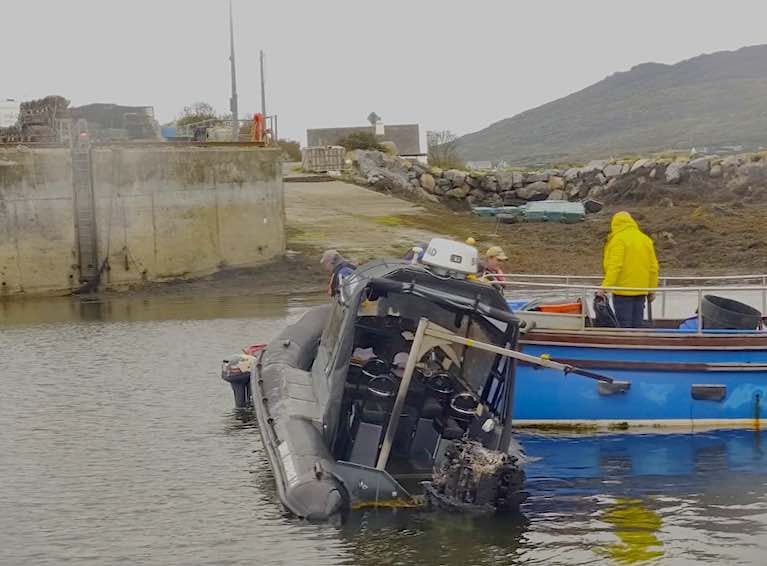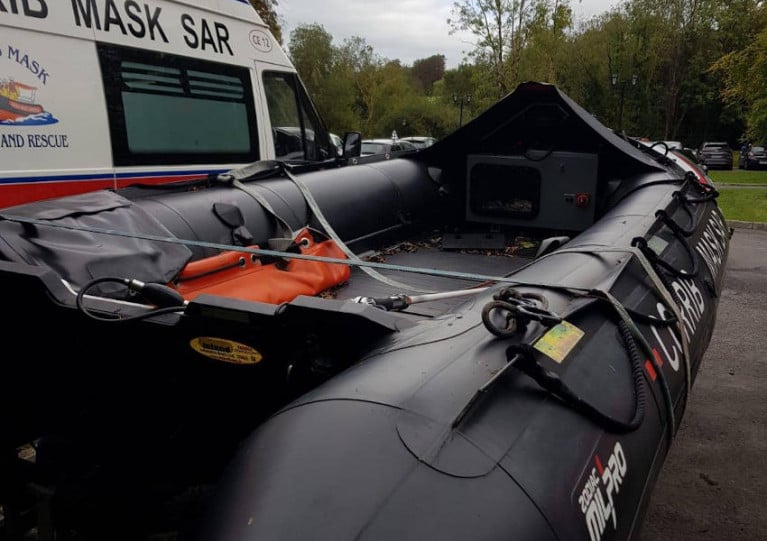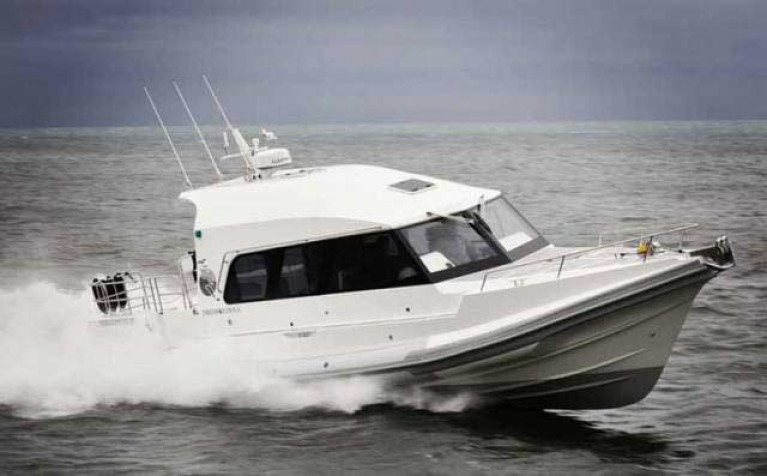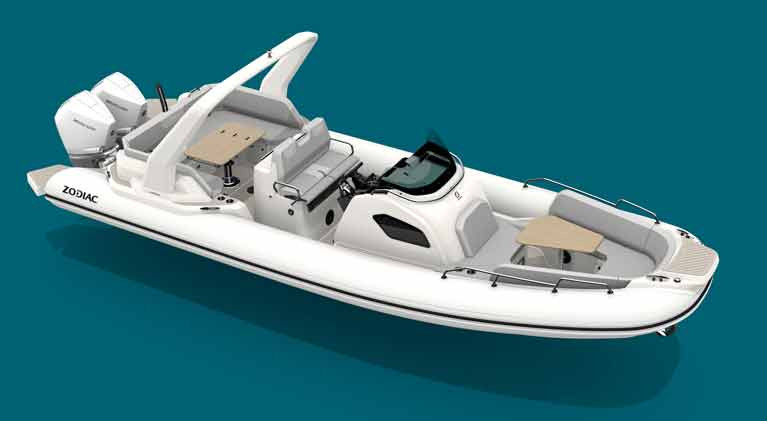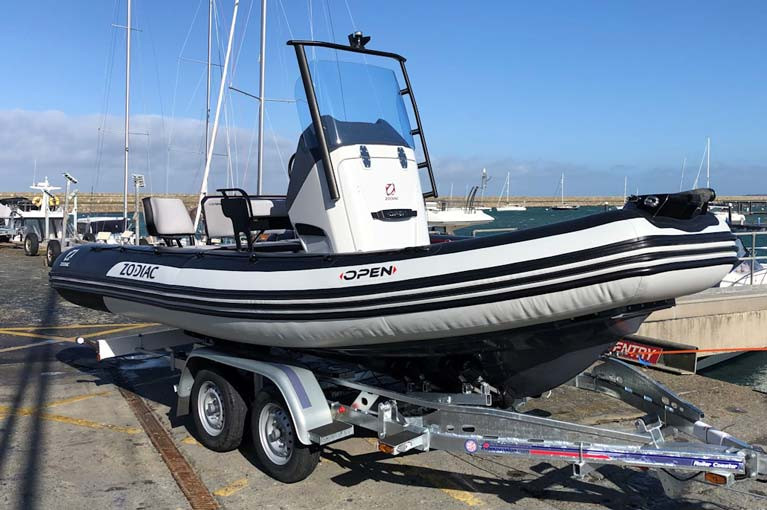Displaying items by tag: Rib
Cork-Dublin Powerboat Speed Record Bid Scrubbed After Engine Loss
John Ryan's planned arrival into Dublin Bay this evening by high speed RIB was scrubbed shortly after his UIM record bid started at Cork Harbour this morning.
Ryan told Afloat "We lost the middle engine, we'll be a no show today".
It's a frustrating scenario for the record-breaker given the current favourable weather forecasts and flat seas.
As Afloat reported earlier, the Royal Cork skipper was due to depart Cork Harbour at 11 am in the 85-mph RIB.
As regular Afloat readers will know, Ryan broke his own existing Cork Fastnet Cork speed record in a time of 1 hour, 47 minutes and 7 seconds (Subject to ratification by UIM) last week as reported here.
The Zerodark team are expected to set a new date for the Cork-Dublin run and other Irish powerboat record attempts too.
Royal Cork's John Ryan Breaks Cork-Fastnet-Cork World Powerboat Speed Record in 80-mph Zerodark RIB
ZeroDark, the big black high-speed RIB driven by Royal Cork member John Ryan, broke his own existing Cork Fastnet Cork speed record in a time of 1 hour, 47 minutes and 7 seconds (Subject to ratification by UIM) yesterday.
The previous record of 2 hours 6 minutes and 47 seconds was set by Ryan when he was team principal of All Black Racing in 2018 as Afloat reported here.
This week, as regular Afloat readers will know, the boat had been turning heads on test runs with its impressive speed around Cork Harbour.
Speaking after the record run, John said “we were delighted to be able to break the existing record and while conditions proved challenging in the latter stages I am really pleased how the boat handled the conditions”. He also paid tribute to his navigator on the day, Ciaran Monks, no stranger to high-speed craft.
 (Above and below) The Zerodark RIB team prepare for the record at RCYC marina
(Above and below) The Zerodark RIB team prepare for the record at RCYC marina



 Fastnet Rock - the halfway point on a perfect evening for a high speed Rib run
Fastnet Rock - the halfway point on a perfect evening for a high speed Rib run
Ryan told Afloat his top speed during the run was 83 knots, but that he lost navigation and all instruments due to an electrical issue after ten minutes from start so the run was by compass only with no trim or engine management. The average speed was 65 knots.
 The record time of 1 hour, 47 minutes and 7 seconds is subject to ratification by UIM record keepers
The record time of 1 hour, 47 minutes and 7 seconds is subject to ratification by UIM record keepers
Colin Morehead, Admiral of the Royal Cork who was assisting the record bid commented – It is great to see John, a member of our club achieving such results today. The yacht club has a strong motor history and it is wonderful to see John and his team perform so admirably today. It was my pleasure to provide him with a special five-gun salute on their victorious return to the yacht club marina this evening”
 (above and below) Record breakers - celebrating at Royal Cork Yacht Club marina after the record time was set, John Ryan (right)and Colin Morehead (second from right) and the Zerodark team Photo: Bob Bateman
(above and below) Record breakers - celebrating at Royal Cork Yacht Club marina after the record time was set, John Ryan (right)and Colin Morehead (second from right) and the Zerodark team Photo: Bob Bateman

ZeroDark was built by Ophardt Maritim in Duisburg, Germany and she arrived by road earlier this week. Designed by Andrew Lee of Norson Design specifically for the German Special Forces as a craft to be utilized for high-speed covert operations.
She has an aluminium hull and is the fastest of its type in the world and can reach speeds in excess of 85 knots.
Ryan says Zerodark will be attempting further records in near future.
Zerodark Cork-Fastnet-Cork Record Run Photo Gallery
A high-speed RIB capable of 80 knots has arrived in Cork Harbour for several 'days of testing' and to 'show its speed capabilities', according to posts on social media.
The RIB, say posters, is here to attempt the Cork Harbour to Fastnet Rock speed record.
The black RIB reportedly 'gently stretched' its speed to 74 knots on a short test run.
As regular Afloat readers will recall, in August 2020, Frank Kowalski's Safehaven Marine in County Cork set a new World powerboat record for Cork - Fastnet Rock – Cork averaging 44.6 knots.
Safehaven Marine set a new over 50ft class Cork to the Fastnet Rock and back UIM World powerboat record in their 23m long XSV20 ‘Thunder Child II’ in a time of 2hrs 36 minutes averaging 44.6kts, recording a maximum speed of 53kts on the run.
The UIM World powerboat records are categorised in three sizes which, if the RIB crew attempts a bid, will be for the 30-50ft record, a separate one to Kowalski's time.
Here's a video of the newly arrived 12-metre RIB vessel off Roches Point posted on social media below.
RS Electric Boats will present their latest generation of electric RIB, the Pulse 63, for the first time at The Green Tech Boat Show 2021 hosted by MDL Marinas at Queen Anne's Battery, Plymouth, 19-20 June 2021.
The world's first electric RIB with a fully integrated electric drive, the Pulse is designed to help individuals switch to a more environmentally friendly way of getting out on the water. With zero emissions, no unpleasant fumes and no risk of oil spills, the Pulse 63 promotes clean boating, and the dynamic and efficient electric propulsion is extremely quiet with minimal wake for discrete operations and a comfortable ride. The electric RIB is also built using sustainable and recycled materials and constructed on British soil to reduce shipping miles.
The Pulse 63 will be presented by the recently appointed RS Electric Boats Commercial Sales Manager, Andy Andrews. Andy brings a wealth of commercial RIB experience and knowledge to the team, including 25 years in the Royal Navy, time working for Oman Sail, Saphire Marine, Berthon, and Gemini Marine, and supplying boats, engines, marine equipment and maritime training courses to UN and Government agencies throughout East Africa.
"We are really looking forward to inviting interested parties to view the new Pulse 63 for the first time at The Green Tech Boat Show," says Andy Andrews. "With zero emissions propulsion, the Pulse 63 provides a unique opportunity for marine-based companies to meet sustainability targets and move towards a greener future. We expect the RIB to appeal to a wide range of organisations, including law enforcement, border protection, security, wind farms, harbour masters, sailing schools and marinas, to name just a few. We also offer leisure and superyacht configurations for private boat owners wanting to reduce their carbon footprint and enjoy time on the water in a way that doesn't harm the planet."
The RS Electric Boats Pulse 63 will be available to view at The Green Tech Boat Show, Queen Anne's battery, Plymouth, 19-20 June 2021 on Stand 21.
Clifden RNLI Launch to Fire on Diver's RIB in Roundstone
Three divers were rescued by the RNLI Clifden lifeboat yesterday after their rigid inflatable boat (RIB) caught fire in Bertraghboy bay near Roundstone, Co Galway.
Shortly before 3 pm yesterday (Monday, Sept 21st) Clifden RNLI launched their Shannon class all-weather lifeboat in response to a Mayday call to the Coastguard from a Rigid Inflatable Boat (RIB) that had caught fire in Bertraghboy Bay near Roundstone.
The three people on board had inflated their life raft, evacuated the RIB and were taken under tow by a local fishing vessel. They had been diving approximately 3 miles offshore when the incident happened.
Clifden RNLI said that the three people on board had inflated their life raft, evacuated the RIB and were taken under tow by a local fishing vessel. They had been diving approximately three miles off shore when the incident happened.
The Shannon class lifeboat Brianne Aldington arrived at the scene approximately 55 minutes after launch, it said.
Aran Island RNLI, which had also been requested to launch, was stood down shortly afterwards - as was Clifden’s Atlantic 85 inshore lifeboat, once it was clear the situation was under control, it said.
The Irish Coastguard helicopter Rescue 115 from Shannon was on scene while the lifeboat escorted the casualties into Inishnee pier, where they were met by members of Cleggan Coastguard.
Coxswain James Mullen said ‘“While this was obviously a very upsetting thing to happen, the boat was very well equipped and the sailors had taken every safety precaution to deal with an emergency scenario like this. “
“We wish them well and commend their quick actions and also of course the local vessel that went to their aid as quickly as possible, in what have could otherwise have been a disastrous incident, “ Mr Mullen added.
Appeal After Motor & GPS Stripped From Lough Corrib Rescue Boat
Corrib Mask Search and Rescue is appealing for any information after its newly acquired RIB was stripped of its motor and GPS equipment.
The Zodiac boat, which was stored in the Cong area, was targeted some time between Thursday (17 September) and yesterday (Saturday 19 September) and stripped it of its Yamaha outboard engine and GPS plotter — valued together at upwards of €10,000.
Anyone in the vicinity of Cong who may have seen or heard anything, or is aware of someone trying to sell the missing parts, is encouraged to contact Claremorris Garda Station at 094 937 2080 or the Garda Confidential line at 1800 250 025.
Red Bay 1150 Cruising RIB is on the Market
The Red Bay Boats 1150 offshore RIB launched by County Kerry boaters John and Adam Brennan two years ago is on the market.
As Afloat reported in December 2018, the stunning all-white vessel has filled the role of luxury day cruiser and long distant explorer but after two years of service is up for sale.
According to the advert on Afloat here, the 'extremely capable cruiser' is in 'perfect condition with every option installed by the manufacturer'.
Launched November 2018 with just over 3,000 miles covered in the 2019 season. It can entertain up to 12 people on day trips. Priced at €295k you can see full specs and photos here.
Renowned hospitality specialist John Brennan of Dromquinna Manor and the Park Hotel in Kenmare in County Kerry is best known for his entertaining and informative “At Your Service” double act on television with his brother Francis. In it, the brothers bounce ideas off each other as they bring their unrivalled expertise to bear on some difficult challenges in product-improvement across a wide range of problematic hospitality establishments all over Ireland.
Yet as anyone who has ever enjoyed the superb food and glorious location of his Boathouse restaurant down by the harbour at the Dromquinna Manor wedding venue and glamping holiday set up on the shores of the beautiful Kenmare River will know, John Brennan has a secret life as a serial boat development enthusiast. His Dromquinna-based flotilla does offer hotel guests the possibility of a speedy voyage down the Kenmare River for some unexpected lunch venues. But those who know him are well aware that really it’s all about John’s abiding impulse to create the perfect fast multi-purpose boat and in pursuit of that he and his son Adam have been working with the specialist RIB development team at Redbay Boats at Cushendall in County Antrim.
 The Boathouse Restaurant at Dromquinna Photo: W M Nixon
The Boathouse Restaurant at Dromquinna Photo: W M Nixon
It’s intriguing that father-and-son boat connoisseurs from the distant southwest of Ireland should be so closely linked to a design and production unit in the far northeast of the country. But the reality is that the development of big multi-purpose high speed RIBs is simply a world apart from the humdrum existence of most of us, and we can only watch in wonder as it attracts folk like infrastructure construction magnate Kevin Lagan, who has steadily worked his way up through the Redbay Stormforce size range such that his current machine – with very comfortable cruising accommodation for six - is all of 58ft long.
John Brennan for his part is particularly interested in the detailed technical side and every aspect of planning, designing and creating a boat which provides good performance and onboard comfort with the maximum eco-friendly credentials. And in Tom McLaughlin’s creative team of Gary Fife and designer Owen McKinley, the Dromquinna duo have found kindred spirits with whom to push the envelope of boat development for John’s requirement for “a serious long-distance cruiser”.
 Hospitality guru John Brennan of Kenmare in Kerry has a secret life as a serial boat design-and-build developer, using the scope offered by the variations possible in the large Redbay Stormforce RIBs built at Cushendall in County Antrim.
Hospitality guru John Brennan of Kenmare in Kerry has a secret life as a serial boat design-and-build developer, using the scope offered by the variations possible in the large Redbay Stormforce RIBs built at Cushendall in County Antrim.
In fact, with a Redbay Stormforce RIB, pushing the envelope is what it’s all about, as the company are cheerfully flexible about size changes as the specification develops. Thus although the Brennans’ Redbay 1150 Dromquinna is now nicely run in and functioning just as planned, even as she was nearing completion John and Adam were well aware that John’s busy mind already had the next boat taking shape in concept form, so the Redbay 1150 Dromquinna is now for sale as progress accelerates on a bigger and more sophisticated craft, due for delivery in April 2021.
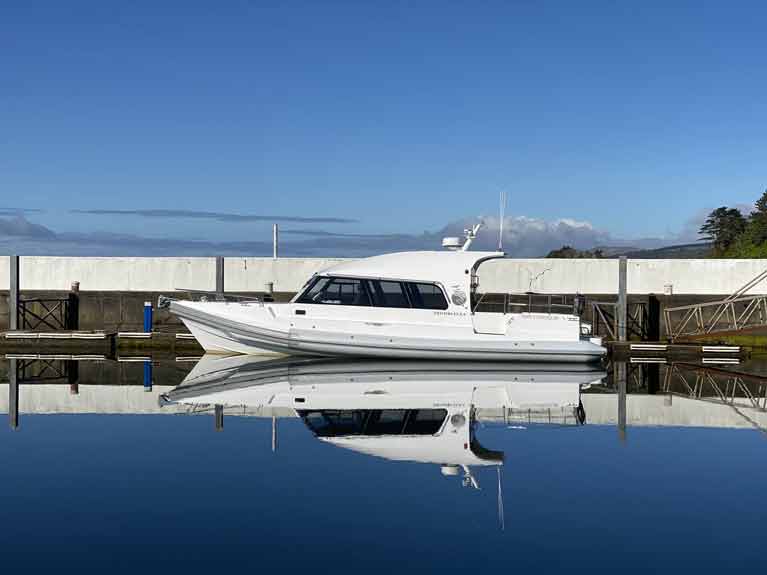 Home berth – the Redbay Storm 1150 Dromquinna at Dromquinna quay in Kerry
Home berth – the Redbay Storm 1150 Dromquinna at Dromquinna quay in Kerry
The most recent set of drawings for the new boat date from March 3rd and illustrate a customised version of Redbay’s Stormforce 14.50. But with a clear programme now in place to guide Dromquinna Manor through the lockdown, the boat team have gone back to the drawing board and we’ll be looking at a Stormforce 16.50 (that’s just over 54ft) with three engines, as an extra two metres length and an additional 0.5m beam were required to accommodate a smaller eco-friendly centre-line engine which will drive her at a gentle 5-7 knots of hyper-economy and minimal pollution for a range of 1800 miles.
However, if you’re in a hurry the big beasts either side will give a top speed of 38 knots, but that only provides 400 miles range, whereas 750 miles is available at 20 knots.
At this boat size, you’re able to provide a second layer of accommodation under the deck saloon, which is an irresistible challenge for someone with John Brennan’s turn of mind. Full-size three-dimensional jigsaw puzzles that would bewilder many of the rest of us are just his thing.
 Dromquinna shows her speed and style – after meticulous planning and attention to detail, this special machine is now for sale as the project is very successfully completed, and her owner seeks a fresh challenge in his new Redbay Stormforce 1650
Dromquinna shows her speed and style – after meticulous planning and attention to detail, this special machine is now for sale as the project is very successfully completed, and her owner seeks a fresh challenge in his new Redbay Stormforce 1650
With almost all waterborne life in Ireland on hold, it’s top creativity time for designers and concept developers to do their thing. At a time when sailboat designer Mark Mills of County Wicklow is our “Sailor of the Month” for his success in designing both successful racing machines and highly developed sailing superyachts, it’s good to know that the lines of communication are red hot between the Mountains of Kerry and the Glens of Antrim as another ingenious Brennan powerboat takes shape.
MGM Boats Announce Medline 9, Zodiac's Biggest Ever RIB
MGM Boats at Dun Laoghaire Harbour have announced the launch of the biggest ever RIB built by international manufacturer Zodiac.
The French RIB builder and their Irish agents are making the most of the lockdown with the virtual launch of its 'big boy', the nine-metre 'Medline 9' RIB.
The new 55-knot top speed craft Medline represents a year and a half of research and development. (Download the spec sheet below).
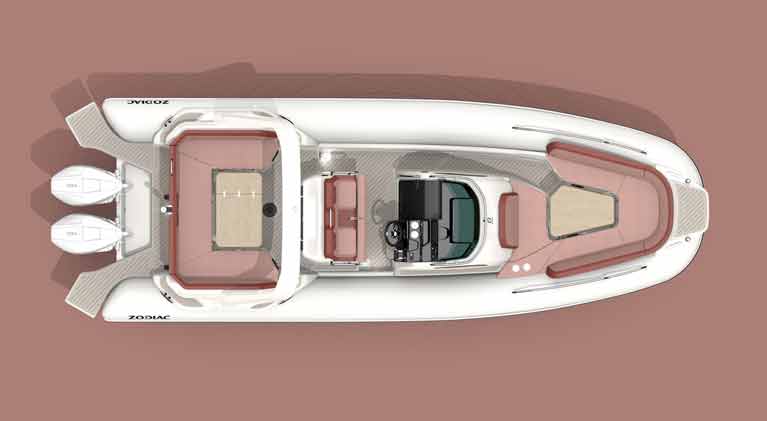 Medline 9 top view
Medline 9 top view
Zodiac already has 20 orders worldwide for the new marque that has yet to have its press sea trials because of COVID-9 restrictions.
Zodiac collaborated with the French agency DEMS to design the boat that accommodates up to fourteen people sitting down. Its clever bolster seat arrangement allows three sittings (two adults and a child). There are seven storage compartments.
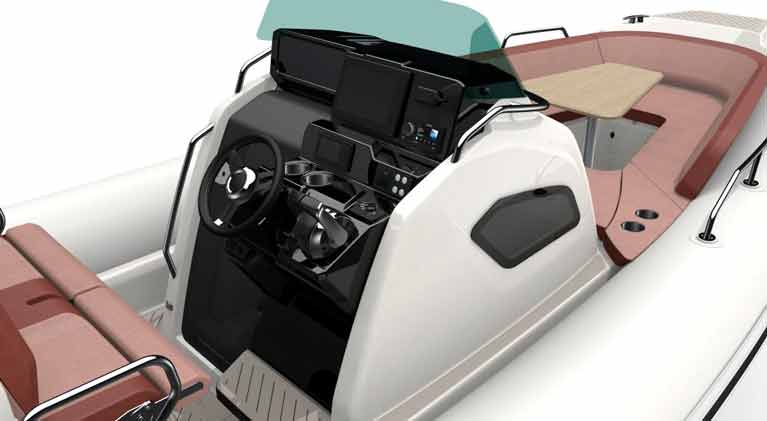 Medline 9 console
Medline 9 console
As a result, the new edition has 'all you need in order to spend a long time on water', says Gerry Salmon of MGM Boats. The boat is equipped with a cabin with a removable bunk, 'so it is possible to overnight onboard or ideal just for a good nap', Salmon adds.
A toilet, a shower as well as a kitchen complete the standard equipment.
Download spec sheet below
MGM Boats describes the new Zodiac Open 5.5 that has recently landed at the boatyard in Dun Laoghaire Harbour as the 'Swiss army knife of boats'.
As regular Afloat readers will know, MGM Boats became Irish Zodiac distributors last December. In announcing the new distributorship, Dublin Bay-based MGM Boats also launched a promotion on the new Open 5.5 metre RIB, a popular size model in Ireland and this March arrival makes good on that promise.
With its excellent sea-keeping performance – thanks to its deep V-hull and its optimised deck plan, the Open is a great starter package and a lot more besides because it is pretty much at ease in all activities.
Thanks to its design, it is easily transportable, even with an inflated tube, it works for getaways, fishing, waterskiing, wakeboarding and sunbathing (we hope!)
The new 5.5 has a Deep V fibreglass hull and a self-bailing deck. Full spec here.
More details from MGM Boats here.




























